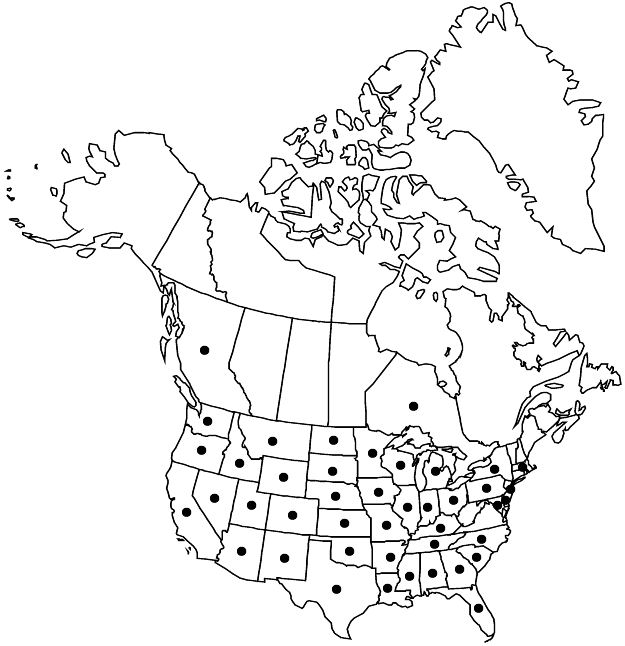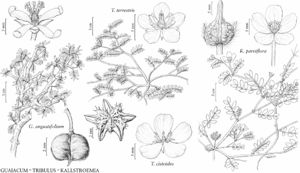Difference between revisions of "Tribulus terrestris"
Sp. Pl. 1: 387. 1753.
FNA>Volume Importer |
FNA>Volume Importer |
||
| Line 60: | Line 60: | ||
|publication year=1753 | |publication year=1753 | ||
|special status=Weedy;Introduced;Illustrated | |special status=Weedy;Introduced;Illustrated | ||
| − | |source xml=https://jpend@bitbucket.org/aafc-mbb/fna-data-curation.git/src/ | + | |source xml=https://jpend@bitbucket.org/aafc-mbb/fna-data-curation.git/src/f50eec43f223ca0e34566be0b046453a0960e173/coarse_grained_fna_xml/V12/V12_77.xml |
|genus=Tribulus | |genus=Tribulus | ||
|species=Tribulus terrestris | |species=Tribulus terrestris | ||
Revision as of 19:56, 16 December 2019
Herbs, annual; herbage hairy (whitish), especially young shoots, becoming glabrate. Stems prostrate, green to reddish, to 1 m, ± hirsute, sericeous. Leaves 2–4.5 × 1 cm; stipules 1–5 × to 1 mm; leaflets 6–12(–16), ovate to elliptic, largest 4–11 × 2–4 mm, densely sericeous, younger parts silvery, becoming glabrate. Pedicels shorter to longer than shorter pair of leaves, in flower 2–7 mm, in fruit 5–15 mm, apex bent. Flowers 5(–10) mm diam.; sepals ovate-lanceolate, 2–4 × 1.5–2 mm, minutely ciliate, hirsute; petals oblong, 2.5–5 × 1–3 mm; outer whorl of nectary glands yellowish, inner whorl distinct, yellow, triangular, 0.2 mm; stamen filaments 2–3 mm; anthers yellow, cordate, 1 mm; ovary 1–5 mm diam.; style 5-ridged, cylindric, stout, 1–1.5 mm; stigma globose. Schizocarps (7–)10–15 mm diam. excluding 4–12 mm spines; mericarps bearing 2 conic spreading 3–7 mm dorsal spines and sometimes 2 smaller retrorse spines near base, body green to gray or yellowish, hispid, strigose, or glabrate.
Phenology: Flowering Mar–Oct.
Habitat: Agricultural lands, roadsides, railways, other disturbed areas.
Elevation: 0–2300 m.
Distribution

B.C., Ont., Ala., Ariz., Ark., Calif., Colo., Del., Fla., Ga., Idaho, Ill., Ind., Iowa, Kans., Ky., La., Md., Mass., Mich., Minn., Miss., Mo., Mont., Nebr., Nev., N.J., N.Mex., N.Y., N.C., N.Dak., Ohio, Okla., Oreg., Pa., S.C., S.Dak., Tenn., Tex., Utah, Wash., Wis., Wyo., Europe, n Africa, introduced also in Mexico, South America (Argentina, Ecuador, Peru), s Africa, Pacific Islands, Australia.
Discussion
Tribulus terrestris, native to the Mediterranean region, is now found throughout drier temperate areas of the world. The species was collected once in Virginia (in 1978) but does not appear to have become established there. Tribulus terrestris is often spread by the spiny mericarps sticking to bicycle or automobile tires and to the feet or coats of livestock. The mericarps also wreak havoc with the bare foot. For an extended synonymy, see H. G. Schweickerdt (1937).
Tribulus terrestris officially has been declared an introduced noxious weed by Arizona, California, Colorado, Hawaii, Idaho, Iowa, Michigan, Nebraska, Nevada, North Carolina, Oregon, Washington, and Wyoming. After attempting unsuccessfully for some 50 years to control it by chemical means, the California Department of Agriculture in 1961 imported two species of weevils from India for biological control. The larvae of both feed selectively on T. terrestris: Microlarinus lareynii on the seeds and M. lypriformis on the stems. These weevils were thought to be well on their way to controlling T. terrestris in the Southwest by the 1970s (D. M. Porter 1972). Unfortunately, however, control is cyclic and not always effective, and the species remains a pest.
In the United States, Africa, and Australia, ingestion of the plant by sheep leads to so-called geeldikkop or bighead, a fatal disease involving hepatogenic photosensitization. Both nitrate and selenium poisoning may be involved (J. M. Kingsbury 1964). Extracts of Tribulus terrestris are now sold on the Internet to treat male infertility and to help build muscle mass.
Selected References
None.
